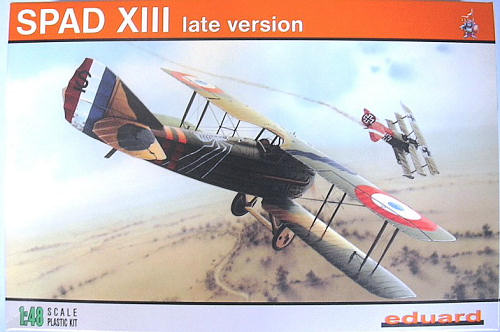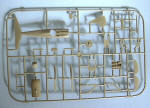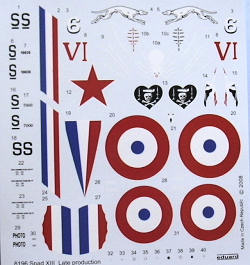
Eduard 1/48 Spad XIII (late production)
| KIT #: | 8196 |
| PRICE: | $34.95 MSRP |
| DECALS: | Four Options |
| REVIEWER: | Tom Cleaver |
| NOTES: |

| HISTORY |
In 1910, Armand Deperdussin founded
the Societe Provisoire des Aeroplanes Deperdussin (SPAD).
The company built racing airplanes designed by Deperdussin; a monoplane designed
by Chief Designer Louis Bechereau in 1913 set a world air speed record of 125
m.p.h. that year. In August 1914, Deperdussin was arrested for embezzlement, but
was released a month later without a final judgement (he was finally sentenced
to five years in March 1917 but never served his sentence) due to the importance
of his company and its products following the outbreak of the Great War.
Louis Bleriot became President of
the reformed company, now known as the Societe Anonyme pour
l’’Aviation et ses Derives which
allowed them to keep the SPAD. Most importantly, Bechereau was retained as Chief
Designer.
After designing the odd-looking
SPAD A.4, a two-seater “fighter” in which the gunner sat in a “pulpit”
immediately ahead of the propeller, Bechereau next designed the SPAD VII C.1,
which utilized the 150 h.p. Hispano-Suiza V-8, armed with a single Vickers using
the Constantinescu hydraulic gun synchronization system. Introduced to combat in
August 1916 in limited numbers shortly after the appearance of the Albatros
D.II, the SPAD VII would be an important part of the French and Italian air
forces for the rest of the war.
At first, the airplane was faster than the Albatros, but
not as maneuverable as its main opponent. With the later 180 h.p. Hispano, the
SPAD VII became not only faster but more maneuverable.
In 1917, Bechereau designed the
definitive SPAD XIII C.1, using the superb 220 h.p. Hispano-Suiza, which allowed
an increase in armament to two Vickers machine guns. While the airplane did
reach the front in limited numbers in the spring of 1917, difficulties in
production, coupled with the necessity of a redesign of the upper wing, meant
that it did not reach the front in appreciable numbers until late 1917 and did
not fully replace the SPAD VII until the spring of 1918.
The SPAD XIII could not have
arrived at a better time, as the last six months of the war saw more intense
combat than the previous three and a half years. The SPAD XIII could fly and
fight at altitudes approaching 20,000 feet, where air combat was now taking
place, and could hold its own with the superb Fokker D.VII.
Every great French ace flew the
SPAD XIII, which also began equipping squadrons of the U.S. Army Air Service in
July 1918, where it saw outstanding service in the three months of fighting in
which the American forces demonstrated they were the equals of their European
allies and enemies.
After the war, the SPAD XIII was used by air forces ranging from that of Czechoslovakia to Japan, and remained in first-line service with the U.S.A.S. until the early 1920s.
| THE KIT |
 Opening the box, one will be
immediately aware that this is one of the best World War I kits yet produced.
Three tan colored sprues present a total 85 plastic
parts, which are supplemented by three clear pieces for different windscreens, a
masking set and a pre-painted photo-etched fret with 29 detail items.
This is definitely NOT the DML kit.
For one thing, the poor photoetch interplane struts of
that earlier kit are replaced here by petite three-dimensional struts that are
just right.
I particularly like the fact that the horizontal stabilizer is
molded with the upper rear fuselage, allowing it to be perfectly thin, with a
strong part that won’t break. (That
is the sprue shown. Ed)
In particular, this upper rear part being one piece
means there is no possibility of losing the stringer detail when the fuselage
halves are joined. The wings are suitably thin with a very good representation
of fabric over the ribs.
Opening the box, one will be
immediately aware that this is one of the best World War I kits yet produced.
Three tan colored sprues present a total 85 plastic
parts, which are supplemented by three clear pieces for different windscreens, a
masking set and a pre-painted photo-etched fret with 29 detail items.
This is definitely NOT the DML kit.
For one thing, the poor photoetch interplane struts of
that earlier kit are replaced here by petite three-dimensional struts that are
just right.
I particularly like the fact that the horizontal stabilizer is
molded with the upper rear fuselage, allowing it to be perfectly thin, with a
strong part that won’t break. (That
is the sprue shown. Ed)
In particular, this upper rear part being one piece
means there is no possibility of losing the stringer detail when the fuselage
halves are joined. The wings are suitably thin with a very good representation
of fabric over the ribs.
How accurate is the kit?
I compared the main parts with the
general arrangement drawings in Windsock Datafile 32,
which are commonly considered the most accurate.
The kit parts match perfectly
The smaller details are excellent,
and while not all the parts can be used in this particular release, a modeler
who has the Windsock Datafile and other decals can pretty much do any
late-production SPAD XIII they wish. I particularly like the inclusion of both
single and two piece cowl arrangements as well as two types of airscrew - the
250 ØØ Éclair series 153 and the Gremont propeller.
The SPAD cockpit was “busy” and
Eduard has really caught this. 30 parts, including instrument dials, seatbelts
and even a map from the photoetch fret.
The result will be one of the best cockpits on any WW1
model.
And OOB!
Decals are provided for four
aircraft:
Sgt Fernand Chavannes, SPA. 112, August 1918; Lt Charles
Nungesser, Escadrille SPA.65, September, 1918; Adjutant Marius Blanc, Escadrille
SPA.81, Summer, 1918; and Capitaine Rene Fonck, Escadrille SPA.103, Fall, 1918.
I particularly like that the markings instructions show
the subtle yet important differences in the camouflage patterns, since all of
these aircraft are from different manufacturers.
| CONCLUSIONS |
Thanks to Eduard for the review kit.
October 2008
If you would like your product reviewed fairly and quickly, please contact me or see other details in the Note to Contributors.